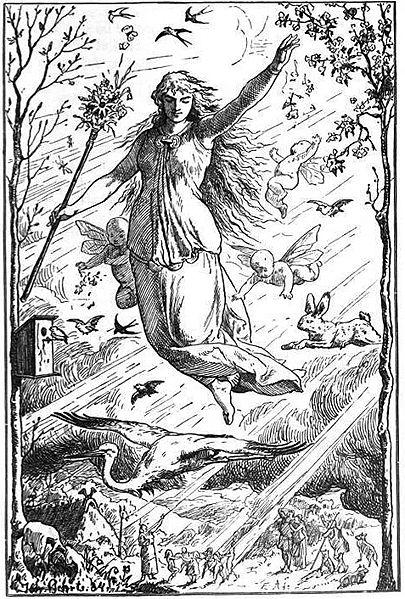Spring officially arrives in the northern hemisphere today. Days will be longer than nights for six months after this and many pagans will be celebrating Ostara. Named after Ēostre, the goddess who apparently gave Easter its name, Ostara is an amalgam of the various equinox feasts and observations of antiquity. The ancient Celts, as far as we know, held four particular holidays that fall roughly halfway between the solstices and equinoxes, with February marking Imbolc and Beltane yet to come in May. We don’t know that they celebrated the equinox, but we don’t know that they didn’t either. Equinoxes are a bit difficult to measure precisely with the sun’s position overhead, but we know the clever folks responsible for Stonehenge and Maes Howe could do such things, even in antiquity.

Ostara laughs to see such sport
" data-orig-size="405,599" sizes="(max-width: 405px) 100vw, 405px" data-image-title="Ostara" data-orig-file="https://sawiggins.files.wordpress.com/2013/03/ostara.jpg" data-image-description="" data-image-meta="{"aperture":"0","credit":"","camera":"","caption":"","created_timestamp":"0","copyright":"","focal_length":"0","iso":"0","shutter_speed":"0","title":""}" data-medium-file="https://sawiggins.files.wordpress.com/2013/03/ostara.jpg?w=203" data-permalink="https://steveawiggins.com/2013/03/24/palming-the-truth/ostara/#main" alt="" srcset="https://sawiggins.files.wordpress.com/2013/03/ostara.jpg 405w, https://sawiggins.files.wordpress.com/2013/03/ostara.jpg?w=101 101w, https://sawiggins.files.wordpress.com/2013/03/ostara.jpg?w=203 203w" class="wp-image-5867" data-large-file="https://sawiggins.files.wordpress.com/2013/03/ostara.jpg?w=405" />Ostara, maybeAccording to Bede the Anglo-Saxons had several feasts for the goddess Ēostre. Luckily (from his perspective), Christians had Pascha (Easter) some time near the equinox. It’s late this year, however, since we just had the full moon (the “Worm Moon”) on Friday. Easter is the first Sunday after the first full moon after the vernal equinox. So today we’ve got Ēostre. We know little of her beyond Bede. Ancient Germanic peoples, like the ancient Celts, didn’t keep extensive written records. Their religions, based on what we know of most ancient religions, were likely lively affairs. Spring is a celebratory season and already buds and blossoms are appearing around here. Goddess or no, there’s a feminine wonderment about the season. It’s difficult not to feel at least a little hopeful.
Ancient deities have long been a source of fascination. Eclipsed by an aggressively political Christianity, many of them vanished without leaving us many traces at all. The human mind seems inclined to create gods to explain this strange but wonderful world we inhabit. It’s clear that it wasn’t made just for us. The birds and insects, and even the elusive reptiles and amphibians, are beginning to reappear. Many mammals and some birds rough it through the cold hoping to emerge again into the warmth of spring. We’ve had some warm days already, but there are likely more cold ones to come. As the pagan gods, as Ēostre remind(s) us, transitions come in fits and starts. Setbacks are part of progress. Many of us believe the moral arc of the universe tends toward what is good and right. It may take a long time to arrive, but the equinox, in its very name, bears the clue.
